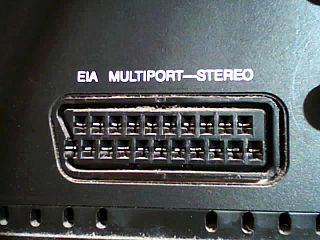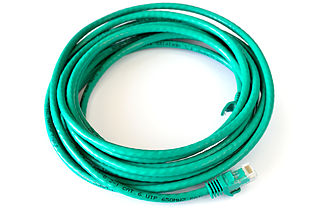In telecommunications, RS-232, Recommended Standard 232 refers to a standard originally introduced in 1960 for serial communication transmission of data. It formally defines signals connecting between a DTE such as a computer terminal, and a DCE, such as a modem. The standard defines the electrical characteristics and timing of signals, the meaning of signals, and the physical size and pinout of connectors. The current version of the standard is TIA-232-F Interface Between Data Terminal Equipment and Data Circuit-Terminating Equipment Employing Serial Binary Data Interchange, issued in 1997. The RS-232 standard had been commonly used in computer serial ports.

Category 5 cable, commonly referred to as Cat 5, is a twisted pair cable for computer networks. Since 2001, the variant commonly in use is the Category 5e specification (Cat 5e). The cable standard provides performance of up to 100 MHz and is suitable for most varieties of Ethernet over twisted pair up to 1000BASE-T. Cat 5 is also used to carry other signals such as telephony and video.

In computing, a serial port is a serial communication interface through which information transfers in or out one bit at a time. Throughout most of the history of personal computers, data was transferred through serial ports to devices such as modems, terminals, and various peripherals.

A registered jack (RJ) is a standardized telecommunication network interface for connecting voice and data equipment to a service provided by a local exchange carrier or long distance carrier. Registration interfaces were first defined in the Universal Service Ordering Code (USOC) system of the Bell System in the United States for complying with the registration program for customer-supplied telephone equipment mandated by the Federal Communications Commission (FCC) in the 1970s. They were subsequently codified in title 47 of the Code of Federal Regulations Part 68.
RS-422, also known as TIA/EIA-422, is a technical standard originated by the Electronic Industries Alliance that specifies electrical characteristics of a digital signaling circuit. Differential signaling can transmit data at rates as high as 10 Mbit/s, or may be sent on cables as long as 1,500 meters. Some systems directly interconnect using RS-422 signals, or RS-422 converters may be used to extend the range of RS-232 connections. The standard only defines signal levels; other properties of a serial interface, such as electrical connectors and pin wiring, are part of the RS-449 and RS-530 standards.

The Electronic Industries Alliance was a standards and trade organization composed as an alliance of trade associations for electronics manufacturers in the United States. They developed standards to ensure the equipment of different manufacturers was compatible and interchangeable. The EIA ceased operations on February 11, 2011, but the former sectors continue to serve the constituencies of EIA.
A crossover cable connects two devices of the same type, for example DTE-DTE or DCE-DCE, usually connected asymmetrically (DTE-DCE), by a modified cable called a crosslink. Such a distinction between devices was introduced by IBM.
RS-485, also known as TIA-485(-A), EIA-485, is a standard defining the electrical characteristics of drivers and receivers for use in serial communications systems. Electrical signaling is balanced, and multipoint systems are supported. The standard is jointly published by the Telecommunications Industry Association and Electronic Industries Alliance (TIA/EIA). Digital communications networks implementing the standard can be used effectively over long distances and in electrically noisy environments. Multiple receivers may be connected to such a network in a linear, multidrop bus. These characteristics make RS-485 useful in industrial control systems and similar applications.

In telecommunications, structured cabling is building or campus cabling infrastructure that consists of a number of standardized smaller elements called subsystems.

Category 6 cable, commonly referred to as Cat 6, is a standardized twisted pair cable for Ethernet and other network physical layers that is backward compatible with the Category 5/5e and Category 3 cable standards.
The RS-449 specification, also known as EIA-449 or TIA-449, defines the functional and mechanical characteristics of the interface between data terminal equipment, typically a computer, and data communications equipment, typically a modem or terminal server. It was an effort to replace RS-232C, offering much higher performance and longer cable lengths, but emerged as an unwieldy system requiring both DC-37 and DE-9 connectors. The effort was eventually abandoned in favor of RS-530, which used a single DB-25 connector. The full title of the standard is EIA-449 General Purpose 37-Position and 9-Position Interface for Data Terminal Equipment and Data Circuit-Terminating Equipment Employing Serial Binary Data Interchange.
International standard ISO/IEC 11801Information technology — Generic cabling for customer premises specifies general-purpose telecommunication cabling systems that are suitable for a wide range of applications. It covers both balanced copper cabling and optical fibre cabling.
Here is a list of Electronic Industries Alliance (EIA) Standards. The EIA ceased operations on February 11, 2011, but the former sectors continue to serve the constituencies of EIA. EIA designated ECA to continue to develop standards for interconnect, passive and electro-mechanical (IP&E) electronic components under the ANSI-designation of EIA standards. All other electronic components standards are managed by their respective sectors. ECA is expected to merge with the National Electronic Distributors Association (NEDA) to form the Electronic Components Industry Association (ECIA). However, the EIA standards brand will continue for IP&E standards within ECIA. As currently authorized, any ANSI standard designated at ANSI EIA-xxx is developed and/or managed by ECA .

In copper twisted pair wire networks, copper cable certification is achieved through a thorough series of tests in accordance with Telecommunications Industry Association (TIA) or International Organization for Standardization (ISO) standards. These tests are done using a certification-testing tool, which provide pass or fail information. While certification can be performed by the owner of the network, certification is primarily done by datacom contractors. It is this certification that allows the contractors to warranty their work.
RS/EIA/TIA-423 is a standard for serial communications. It defines an unbalanced (single-ended) interface, with a single, unidirectional sending driver, and allows for up to 10 receivers. It is normally implemented in integrated circuit technology and can also be employed for the interchange of serial binary signals between DTE & DCE. There is no common pinout for RS-423. The BBC Micro computer used a 5-pin DIN connector. DEC used it extensively with a Modified Modular Jack connector. This was sometimes called "DEC-423".
ANSI/TIA-568 is a set of telecommunications standards from the Telecommunications Industry Association (TIA). The standards address commercial building cabling for telecommunications products and services.
The Telecommunications Industry Association (TIA) ANSI/TIA-942-A Telecommunications Infrastructure Standard for Data Centers is an American National Standard (ANS) that specifies the minimum requirements for structured cabling work defined in TIA/EIA-568, and is often cited by companies such as ADC Telecommunications and Cisco Systems. The standard was updated with an addendum ANSI/TIA-942-A-1 in April 2013 from the TR-42.1 Commercial Building Telecommunications Cabling Subcommittee, the formulating group that oversees development of the standard. The Telecommunications Industry Association does not offer certification programs or certify compliance to TIA standards. In many cases, there are other organizations and consultants that can provide those services. However, TIA does not certify these organizations or consultants. This is similar to how organizations like ISO operate where they rely on Certification Bodies to ensure that there is oversight over organizations performing such activities.
In telecommunications, RS-366, later known as EIA-366, defines a standard for serial communications between computers and an auto dialer, which is used to dial telephones. It was intended to be used to automate the operation of modems. The standard uses the same DB25 connectors and electrical signalling standards of the well-known RS-232 standard, which RS-366 was designed to support. The CCITT had a matching standard, V.25.










